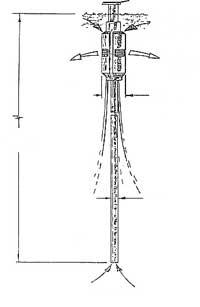Thermal energy energy

The idea is not new, as it was quoted by Jacques Arsene d'Arsonval in 1881. However, the first attempt at exploitation did not arrive until 1930. Georges Clause built an open cycle model in the Matanzas Gulf, on the north-western coast of Cuba. It had a power of 22 kilowatts, but consumed more than what was produced by the system. In 1979 a closed cycle system was built in the same place, reaching a net power of 15 kilowatts during the two years of testing. In 1981 the Japanese built a new closed cycle system and reached a net power of 35 kilowatts. Currently only in Japan and Hawaii there are experimental plants for the use of thermal energy from the oceans. Hawaii has a power of 240 kW. However, this new technology has not yet been economically viable.
What is the thermal energy of the oceans?
The
thermal energy of the oceans is the energy obtained from the temperature difference between the surface and deep waters of the oceans, that is, from the thermal energies.
The ocean is basically a great heat exchanger. According to some calculations, the solar radiation absorbed daily by the tropical seas amounts to 170,000 million barrels of oil (a figure that has also increased to 250,000 million barrels). That is very tempting, of course, and they start trying to exploit it.
However, for the process to be thermally cost-effective, a minimum temperature difference between the hot and cold zone of 18-20ºC is required. In addition, due to technological problems, cold water extraction is usually not recommended at more than 1,000 m of depth. Both conditions occur only in the tropical and subtropical oceans (see Figure 1), between 20°N and 20°S.
Applications

Electricity production is the most versatile option in the possible uses of the thermal energy of the oceans (tests have been conducted in several countries). For this purpose, a closed cycle system and an open cycle system have been developed.
In the closed cycle system (Figure 2), low-boiling liquid, such as ammonia, evaporates through hot water from the sea surface and passes through turbines. Then the cold seabed water liquifies the ammonia, restarting the process. Turbines generate electricity.
The liquid
used in the open cycle system (Figure 3) is the hot water on the sea surface. Hot water enters the vacuum chamber, evaporates and passes steam through the turbine to condense it again and remove it with cold water. In 1982 the Japanese plant had a power of 40,000 watts and in May 1993 the plant built in a test held in Hawaii had a power of 50,000 watts.
It
can also form a hybrid system that unites them. But in addition to producing electricity, they can also be used to obtain fresh water if an open and hybrid cycle system with surface capacitors is used.
In addition to these two main uses, the cold water extracted from the seabed, rich in nutrients, can be used in nurseries (Hawaiin is used in the cultivation of salmon, trout, lobsters, oysters, clams and sea ears). In Japan, the extraction of mineral substances from marine waters, specifically uranium, is being investigated, with the necessary energy source being the thermal energy of the oceans. On a more theoretical level, the possibility of using cold water from the seabed in air conditioning systems has also been mentioned. The use of ocean thermal energy in the sea for the production of hydrogen, ammonium or methanol has also been mentioned.
Barriers

One of the barriers is the lack of sufficient technological development for these systems, but the main obstacle is the enormous cost of building such plants: The construction of an OTEC-MW power plant requires about 2 billion dollars, the construction of a 1,000 MW thermal power plant between 20 and 60 million dollars and the construction of a 1,000 MW nuclear power plant between 700 and 3.5 billion dollars. The pipes to be used and located in the seabed are the most important for the construction of the OTEC-PLANT facilities, both for the work environment and for the special materials to be used in the construction of the pipes.
On the other hand, the last problem that has been raised with electricity thus obtained is whether it is worth taking it to the coast or if it is preferable to use an intermediate product (mainly aluminum, ammonia,
methanol and fresh water) for its manufacture. As
for the environment, this technology does not use non-renewable energy sources or does not generate large amounts of CO2. However, these buildings can have local effects, among others, the ecological distortion due to the alteration of the temperature of marine waters caused by the mixture of layers of water (and the variation of the concentration of salinity and nutrients associated) and the changes in the growth and production of living things (algae, fish, corals, etc. ). Of course, it should be analyzed if it has other consequences.
Buletina
Bidali zure helbide elektronikoa eta jaso asteroko buletina zure sarrera-ontzian











